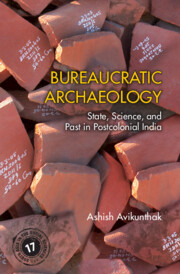Book contents
- Frontmatter
- Dedication
- Contents
- List of Figures
- Preface
- Acknowledgments
- Note on Transliteration
- List of Abbreviations
- 1 Anthropology of Archaeology
- 2 The Making of the Indus–Saraswati Civilization
- 3 Bureaucratic Hierarchy in the ASI
- 4 Spatial Formation of the Archaeological Field
- 5 Epistemological Formation of the Archaeological Site
- 6 Theory of Archaeological Excavation
- 7 Making of the Archaeological Artifact
- 8 Performance of Archaeological Representations
- 9 The Absent Excavation Reports
- Conclusion
- Bibliography
- Index
7 - Making of the Archaeological Artifact
Published online by Cambridge University Press: 20 August 2021
- Frontmatter
- Dedication
- Contents
- List of Figures
- Preface
- Acknowledgments
- Note on Transliteration
- List of Abbreviations
- 1 Anthropology of Archaeology
- 2 The Making of the Indus–Saraswati Civilization
- 3 Bureaucratic Hierarchy in the ASI
- 4 Spatial Formation of the Archaeological Field
- 5 Epistemological Formation of the Archaeological Site
- 6 Theory of Archaeological Excavation
- 7 Making of the Archaeological Artifact
- 8 Performance of Archaeological Representations
- 9 The Absent Excavation Reports
- Conclusion
- Bibliography
- Index
Summary
The ASI was a “well-oiled” (chalu aur chust) bureaucratic postcolonial system— conducting an archaeological excavation with “as much scientific care as possible [jitana sambhav] for a governmental [sarkari] organization,” an assistant archaeologist (AA) at Dholavira dryly told me during one of our conversations, as we walked in the excavated streets of the Lower Town. Every morning at the stroke of the bell, the laborers who had arrived earlier for the roll call would slowly walk toward the site and enter the excavation trenches. I would sometimes get up very early in the morning to see this ritual as hundreds of men and women, wrapped from head to toe in faded woolen blankets and shawls, emerged from the early morning mist. These workers would walk toward the excavation site in a regimental fashion, mostly barefoot, some in rubber flip-flops and others in worn-out plastic footwear—not with the military trot that Wheeler would have desired, but more like a ragtag army of tired subaltern rebels, despairingly carrying the tools of their trade (see Wheeler 1948, 318–21).
Men hauled pickaxes and spades on their shoulders, and women bore basketfuls of brushes, trowels, ropes, and pegs on their head. Around the same time, from the tents of the camp, the ASI supervisors, students, and the AA along with the site director would enter the excavation site attired very differently— jeans, cotton shirts, synthetic wind-cheaters, leather jackets, sweaters, cricket hats, baseball caps, and sneakers. They would be carrying nylon backpacks and bags stuffed with the tools of their trade—towels, plastic water bottles, rulers, pens, pencils, clipboards, measuring tapes, torchlights, brushes, a geometry box, and a knife. In a matter of minutes, the excavation trenches would teem with activity that seemed organized and coordinated—with each worker performing their pre-assigned duty, but, as I have shown earlier, encompassed within a social– cultural ecology that was riddled with caste, class, and professional hierarchy.
Each actor at the excavation site had a specific task, which was watchfully carried out in a synchronized manner. Looking from the top of the fortification mound at Dholavira or the top of the habitation mound at Baror and Bhirrana, I could not fail to realize the labor-intensiveness of an ASI archaeological excavation.
- Type
- Chapter
- Information
- Bureaucratic ArchaeologyState, Science, and Past in Postcolonial India, pp. 178 - 204Publisher: Cambridge University PressPrint publication year: 2021

